A short follow-on from midday’s forward-looking article, noting that there’s much more that could be delved into sometime in future when we (or someone else!) have more time available.
Note – done in a rush, might be errors!
(A) Reserve Trader (RERT) dispatched
In short order this afternoon, the AEMO negotiated supply of Reserve Trader (RERT) from their shortlisted panel (as I noted earlier), and also dispatched the Reserve Trader as noted in Market Notice 72889:
_________________________________
Notice ID 72889
Notice Type ID Reserve Contract / Direction / Instruction
Notice Type Description MARKET
Issue Date Thursday, 23 January 2020
External Reference RERT DISPATCHED
_________________________________
AEMO ELECTRICITY MARKET NOTICE.
AEMO Intervention Event, Reliability and Emergency Reserve Trader (RERT) – NSW1 Region- 23/01/2020
Refer AEMO Electricity Market Notice no. 72886
AEMO has dispatched/activated reserve contract(s) to maintain the power system in a Secure and Reliable operating state.
The reserve contract(s) was dispatched/activated at 15:30 hrs 23/01/2020 and is forecast to apply until 17:30 hrs 23/01/2020
AEMO has implemented an AEMO intervention event for the duration the reserve contract(s) is dispatched/activated/
To facilitate the RERT process, constraints commencing with the following identifiers may be evident at various times in dispatch,
#RT_NSW1
Manager NEM Real Time Operations
One question that a more knowledgeable reader can help me with – Reserve Trader was dispatched from 15:30 to 17:30 (i.e. essentially an out-of-market intervention that implies that the market “failed” in not having enough reserves available), and yet the spot price was not held at the Market Price Cap for that entire time. Why was this the case? What am I missing?
(B) Broader calls for conservation
We also saw the AEMO call more broadly for conservation of energy across the NSW Region – such as in this notice on Twitter, which Craig Memery at PIAC gave a helping hand to circulating:
This was also echoed by that State Energy Minister that “no-one in Federal Cabinet knows” (not that that should be taken as an insult, as some probably don’t know how to tie their own shoelaces):
(C) But only a single dispatch interval at MPC!
With all of the above we would have (ordinarily) thought to see more prices up near the price cap – instead just 14:10 as shown in this snapshot from ez2view:
Interesting to highlight here the effect of the price differential between NSW (at the Market Price Cap) and VIC (down at –$40.05/MWh) has on portfolios that have assets in both regions – like Snowy Hydro shown in this schematic. We can see over 2,000MW being produced in NSW from the Tumut plant but 0MW from Murray (as they would understandably would want to avoid operating at negative prices).
The “N::V_UTYS_2” constraint which is bound and affecting the output of many plant in NSW is also shown below to be acting to reduce the output of Tumut 1& 2 (UPPTUMUT) and Tumut 3 (TUMUT3) because of the high positive factor:
… however we see the output of TUMUT 3 in the ‘Unit Dashboard’ widget in ez2view actually ramping up:
Because the local Connection Point Dispatch Price (CPD Price) for TUMUT3 was down at –$993.64/MWh we know that it must have been bidding at least that low (at the RRN) to be dispatched. So we have the case where:
(1) Snowy Hydro is bidding below –$993 for TUMUT3 in order to be dispatched (and paid the Market Price Cap Dispatch Interval price in the NSW Region – adjusted for the 5/30 issue)
(2) Snowy Hydro is bidding MURRAY out of the market in the VIC Region because it does not want to be dispatched at the negative prices that have been running for the afternoon
(3) The combined 2,000MW that is being produced in NSW from the Tumut plant (along with all the other production in NSW) is jamming the VIC-NSW interconnector to reduce flows north – or indeed to max it out flowing south, at a time when people in NSW are being asked to conserve power (and some are being paid through RERT).
Strange times indeed…
———————————-
PS – using Thursday’s events to fine-tune the ongoing development of ez2view
As noted before, we engage in forensic analysis of NEM events (like this one) for several reasons, including two big ones.
Hence (as time permits) we’ll look forward to producing a more considered Case Study of what went on – however (because of where we are at with this particular project) I thought it would be useful to quickly review two specific dispatch intervals yesterday using the new version of the ‘NEM Prices’ widget that is being designed to replace the existing one within ez2view. There are specific reasons we’re redeveloping this widget (including details discussed specifically with a particular client). Big ones include:
Reason 1 = ensuring it works with Time-Travel within the installed ez2view (such as is shown in this image below).
Reason 2 = ensuring it provides better visibility when used in ez2view online via a small screen (e.g. on a phone, so users can also still read the FCAS prices).
14:10 dispatch interval – first price spike to Market Price Cap
Here’s one snapshot of the 14:10 dispatch interval with the price spiking to the Market Price Cap in the NSW region:
Interesting (at least to us) to note that also:
1) The Raise Regulation price on the mainland jumped to almost $300/MWh at the same time; whilst
2) The Raise Contingency 6-second price in Tassie was up over $10,000/MWh!
18:45 dispatch interval – third price spike to Market Price Cap
At the time I had published the article above (i.e. 15:55) there had only been that spike above – however there were two more later that day. Here’s the third one shown, where we can see the QLD region price also high:
Raise Regulation price still quite high, some hours later – something to keep in mind, in terms of ‘Causer Pays’ liabilities…
17:30 dispatch interval – second price spike to Market Price Cap (one with Intervention)
The AEMC’s recently changed the rules in relation to what AEMO does in relation to Intervention in the market (in the Generator Report Card 2018 we showed how intervention featured in 25% of all dispatch intervals through 2018 partly as a result of learnings out of Sept 2016, but the way of managing this in future won’t see as many periods of intervention).
However 17:30 on Thursday afternoon saw one occasion where intervention did happen. The new widget allows us to toggle between pricing achieved in the ‘Financial’ Run (i.e. which determines what generators are paid) and the ‘Physical Run’ (i.e. which sets a ‘dispatching price’ based on who’s actually dispatched and how, net of the intervention). Here’s two images:
1) Financial Run on the left
2) Physical Run on the right.
Note the huge difference in the price for QLD and NSW regions in the ‘physical run’.
Looking forward to having this widget accessible to clients!


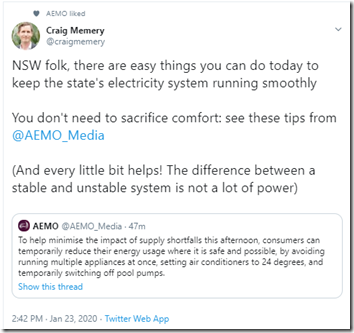
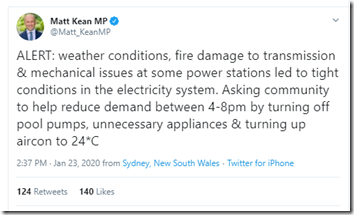
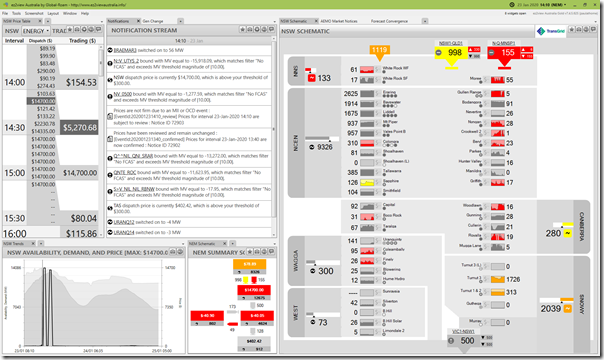
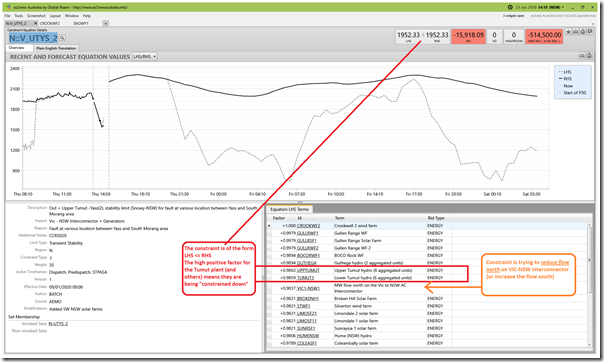
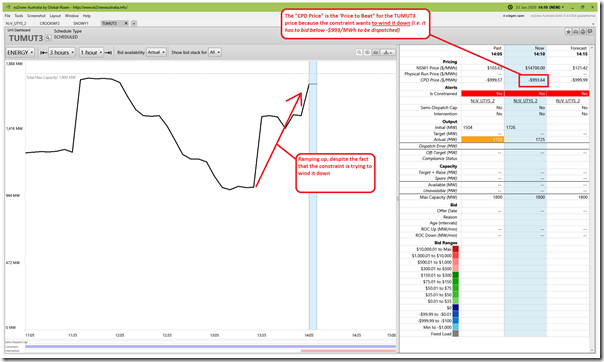
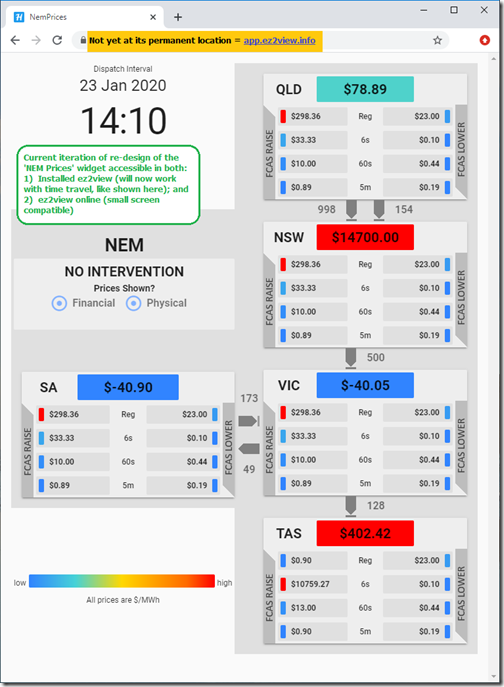
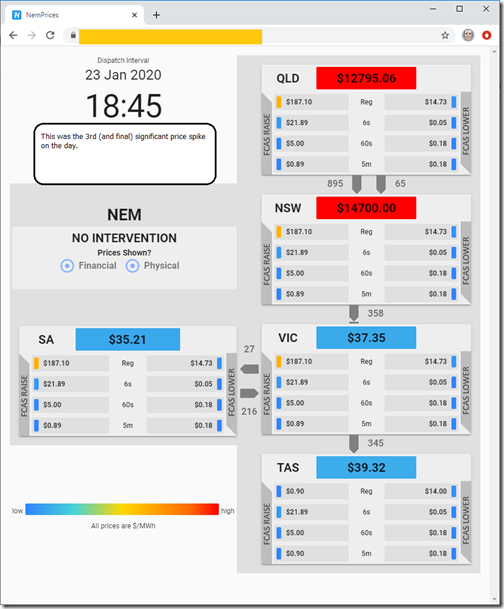
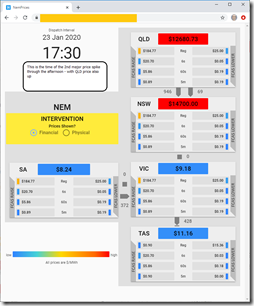
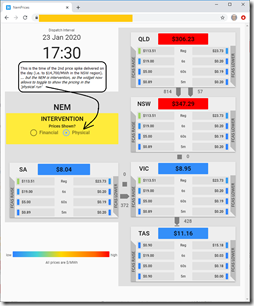
Paul
A couple of quick responses to your questions on pricing under RERT dispatch and observations on the southern NSW constraint.
When RERT is dispatched, intervention pricing (also known as “what-if?” pricing) is used to determine spot prices. This attempts to back out the effect of the RERT contracts (so add them back to demand if they were demand reduction agreements) and work out what the price would have been. If enough supply was offered below market price cap to meet demand with RERT added back in this way, the resulting price will be below MPC.
This differs from the situation where AEMO orders *involuntary* load shedding in which case the price *is* automatically set to MPC.
On the southern NSW constraint, its effect as I understand it is to limit aggregate flows from southern NSW into the rest of NSW, due to reductions in transmission capacity caused by the fires on January 4th (specifically damage to the Upper Tumut – Yass 330kV O2 line). Whether those flows come from Snowy generation, Victorian imports, or other southern NSW generators doesn’t really matter. Unless I’m missing something, Snowy’s generators bidding in more volumes at low prices doesn’t *reduce* the overall flow available into the rest of NSW, it just displaces other generation or imports within the same overall flow limit. When we see “forced exports” from NSW to Vic in this situation it isn’t because less power is getting to the rest of NSW, it just output from generators on the south side of the constraint which *exceeds* the available northward capacity finding its way into Victoria instead.
Allan
I should add though that Snowy’s generators being paid the NSW price even for the excess generation they force into Victoria isn’t really an economically efficient outcome, it just reflects one of the “compromises” in NEM market design where all generators in a region are paid the regional spot price, regardless of where their energy actually goes.
Thanks for the reminder about the mechanics of pricing under RERT, Allan. I was thinking more philosophically …
Viewpoint #1) I’d been thinking of RERT as an “out-of-market” intervention (i.e. in essence a sign that the market had “failed” to deliver sufficient capacity – and that, as a next-to-last resort, better to pay those who volunteer to turn off rather than proceed to (much less surgical) Under-frequency Load Shedding.
Viewpoint #2) However perhaps today is an example of a more risk-averse & precautionary approach to dispatch (i.e. the prices delivered might might be read to suggest that whatever was triggered in Reserve Trader was not actually have been required, in the wash-up (of course, with hindsight being a wonderful thing that just does not exist ahead of time – especially with it needing to be triggered (at 13:26) 120 minutes (or 90 minutes ?) ahead of dispatch starting 15:30 (or trading period ending 15:30?))).
Interested to know if others perceive things the same way, or differently?
The economically rational approach for Snowy would be to run the Jindabyne pump, which pays the Vic pool price (negative $200/MWh at times today so Snowy gets paid to use power), while also generating at capacity in Tumut 3 and getting paid $14,000/MWh in the NSW pool. These economic absurdities will strengthen the case for Humelink and Keranglink as transmission investments to increase the Vic-NSW capacity.
Is there a correlation between wind strength (not power output) and high temperature?
Because the charts show wind dropping off in the afternoon.
Several wind farms turned off during the afternoon – perhaps through transmission limitations. Boco Rock, Crookwell, Gullerin Range, in all about 350 MW missing, or perhaps displaced by more strongly negative bids from Tumut 3.
Several wind farms turned off during the afternoon – perhaps through transmission limitations. Boco Rock, Crookwell, Gullerin Range, in all about 350 MW missing, or perhaps displaced in their access to the transmission network by more strongly negative bids from Tumut 3.
Ben & Malcolm
There were a lot of different things going on. Extreme wind conditions were affecting some of the wind farms throughout the day, causing them to reduce output to quite low levels to protect equipment. Paul’s article mentions the constraint limiting flows north out of southern NSW – there was also a constraint limiting southward flows into Vic to 500 MW, and when this one bound as well it forced offloading of generators in southern NSW, including the windfarms. On a quick scan most of those generators had offered at -$1,000/MWh so should have shared the offloading proportionately, but Snowy had craftily rebid its downwards ramp rate at Tumut 3 so as to limit how much of this offloading it actually wore every five minutes, likely meaning that windfarms took more than their share of the output reduction. This sort of ramp rate rebidding has occurred in the past and needless to say has caused some controversy.
Allan